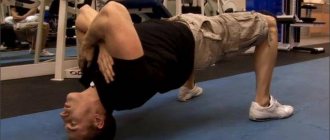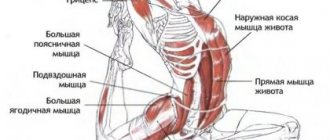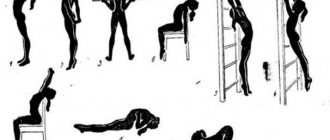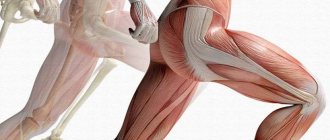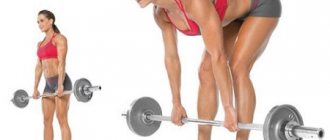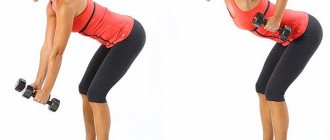What is anterior pelvic tilt
If your posture is like this... and not like this:
then you have what is called an anterior pelvic tilt.
Some believe that it is caused by weak and overstrained muscles and that this leads to back pain, injuries and other spinal problems. And training in the gym is contraindicated for such people.
Others say that this is normal and cannot be changed, so there is no need to worry.
In short, forward pelvic tilt is one of the variants of the normal structure of the human body. Most often this is not a cause for any concern. The only problem is incorrect posture, which can be corrected quite easily.
Pelvic tilt is determined by whether your hips tilt in relation to your body, forward or backward.
This is what it looks like:
Side view:
And here's another diagram of your hip bones at the same angle:
As you can see, there are two points that are of particular interest:
Posterior superior iliac spine, or PSIS.
Anterior superior iliac spine, or ASIS.
When you draw a line between ASIS and PSIS, you get the pelvic angle.
If ASIS is lower than PSIS, this corresponds to an anterior pelvic tilt, if on the contrary, then it corresponds to a posterior tilt, and if they more or less coincide, this corresponds to a neutral position of the pelvis.
Why does my back hurt when I tilt my head forward?
If your back hurts when you tilt your head forward, this may indicate a pinched nerve in the neck. The spinal canal in the cervical region is very narrow, and the area of the spine itself is characterized by great mobility, therefore pinching in it is not uncommon. When the head is tilted, the pinching of the nerve intensifies, and if the point of its exit is in the back, then the pain erodes along the nerve tissue into this area.
Back diseases
Various diseases of the spine can cause pain symptoms. They can be distinguished by their characteristic accompanying symptoms:
- Osteochondrosis is a systemic disease of articular tissue and intervertebral discs, in which the vertebrae come closer together. It can manifest itself in several parts of the spinal column at once;
- Neoplasms, malignant/benign, can compress the nerve. Their presence is established during CT, MRI, ultrasound;
- A hernia or protrusion is accompanied by pain at the location and constantly compresses the nerve, but in certain positions the discomfort can increase;
- Displacement of the vertebrae (spondylolisthesis) occurs after injury. With it, the bone formation changes its normal position, squeezing adjacent tissues;
- Injuries, fractures, cracks in the vertebrae;
- Stenosis of the intervertebral canal is accompanied by dizziness and headaches, since in addition to nervous tissue, blood circulation is inhibited;
- Osteophytes - growths of bone tissue can produce compression;
- The local inflammatory process causes swelling and compression;
- Curvature of the spine, scoliosis is noticeable visually. As a result of curvature, the intervertebral discs of a certain area of the spinal column are subjected to maximum pressure, the vertebrae are brought closer together, and pinching occurs;
- Ankylosing spondylitis is associated with the filling of voids in the joints. Characterized by very severe pain;
- Myositis is an inflammation of muscle tissue, in which a spasm may occur, causing constriction;
- Lumbago is a long-term pinched nerve root. Pain in the spine when tilting the head forward is very intense, manifests itself only when moving, and has the character of a lumbago;
- Radiculitis is a condition similar to lumbago - a habitual long-term pinching of nerve tissue.
If a nerve has been pinched, the discomfort is sharp and increases significantly with movement. With inflammation in soft tissues and muscles, unpleasant sensations are constantly present, are aching in nature, and become acute only when changing body position.
Diseases of internal organs
The described symptoms may be secondary. In this case, the problem causing it is not in the spine, but in the internal organs. When bending forward, discomfort may occur if:
- Gynecological disease. Accompanied by characteristic gynecological symptoms - abdominal pain, menstrual irregularities, bleeding, hormonal imbalances;
- Other inflammatory processes in the pelvic area in men and women. Also accompanied by pain in the lower abdomen;
- Presence of stones in the ureter - when bending forward, the stone injures the ureter. The pain is sharp, appears during the very movement, and fades away gradually, rather slowly;
- Oncological diseases, benign formations, when the tumor compresses the nerve. It is very difficult to independently determine the course of such a process, since the symptoms are standard for pinching, and tumors are also not visible on x-rays. Ultrasound, MRI, CT can help;
- Psychoneurological diseases and somatic abnormalities are diagnosed when, after a thorough examination of the patient, the possibility of another pathology is excluded.
Diseases of internal organs can pose a significant threat to health and life. Therefore, it is important to pay attention to the symptoms accompanying back discomfort in order to consult a doctor in a timely manner.
What Causes Anterior Pelvic Tilt
Most people believe that anterior pelvic tilt is caused by an imbalance between the muscles in the back and the front of the pelvis (hip). The back is stronger than the thigh muscles.
This seems plausible because the pelvis is supported by several powerful muscles and ligaments, including the glutes, biceps, hip flexors, and abdominal muscles. If one or more of these muscles is much stronger than the others, this can lead to poor posture.
Therefore, it is often stated that people with anterior pelvic tilt have weak glutes, biceps and hip flexors or abs, creating an imbalance known as crossed syndrome, which looks like this:
The problem with this theory is that it contradicts physiology because anterior pelvic tilt is a variant of normal human anatomy.
For example, in one study of 120 subjects, 85% of men and 75% of women had some degree of anterior pelvic tilt but did not experience back or hip pain. Research has also shown that most people have a pelvic tilt of about 12-13 degrees.
You might say that just because this condition is so common doesn't mean it's normal.
But there have been other studies that have shown that there is no connection between muscle strength and the structure of the pelvis, which makes you wonder whether muscles affect the angle of inclination at all.
Additionally, it is unlikely to increase the risk of injury or pain when you exercise.
The angle of the pelvis changes with different exercises. Therefore, if your hips are in a neutral position when you just stand, this angle changes when you squat, walk, run, or ride a bike.
What is the cause of this condition
Scientists haven't figured it out yet. Currently, the most popular hypothesis is that the condition is caused by the shape of the pelvic bones itself, which varies from person to person.
Options[edit | edit code]
Bent over squat[edit | edit code]
Place your feet hip- or shoulder-width apart and assume hollow body pose. Move your pelvis back (as if you are closing a door with it) and bend your knees. If you can touch the floor with your fingers, then further progression is to, increasing the amplitude, reach the floor with your palms. This is an excellent forward bend modification for people with bad knees because it allows you to squat while putting most of the stress on your hips and hips. The quadriceps muscles of the thighs also work without the need for deep flexion of the knee joints.
Bend forward on one leg while lifting the other leg[edit | edit code]
This is the ultimate test of your ability to maintain balance while standing on one leg. During this exercise, all muscles that are in one way or another adjacent to the pelvic area actively work. Spread your legs shoulder-width apart and assume a hollow body pose. Extend your arms in front of you. Moving your pelvis back, lean forward and lift your straight leg, stretching it back. Balance for 2 seconds, then return your body to a vertical position and at the same time bring your free leg forward, extending it in front of you. Complete all reps and then switch legs (or switch legs after each rep). Throughout the exercise, be careful not to round your back.
Bend forward on one leg with a jump[edit | edit code]
Bend forward on one leg. Returning to the starting position, make a sharp swing with the knee of your free leg forward and jump, as if through a jump rope. Land softly and continue. After completing the required number of repetitions, change legs.
Seated forward bend[edit | edit code]
This option allows you to perform movements associated with bending forward in isolation, without the need to expend effort on maintaining balance while standing on your feet. Sit on the step platform, tighten your abdominals, pull your shoulders and chest down. Lean forward, bending at the hips until your stomach and chest rest on your thighs. Maintain a natural curve in your lower back. At the end of the exercise, return to the starting position, straightening your body and pushing your pelvis forward. You can experiment with the height of the step platform.
Bent-over lunges[edit | edit code]
The concept here is the same as in the first option (bent squat). Lean forward until your body is parallel to the floor and bend your knees slightly. The bent lunge is not as big as when performing standard lunges; the leg does not go far from the center of gravity. Lunges can be done forward (a) or to the side (b), crosswise or even with a turn. The goal of all of these variations is to work your thigh muscles harder and take pressure off your knees, while still allowing some work for your knees and quadriceps. Lunges of this kind are more applicable to everyday activities and sports because in life you have to bend over much more often than to drop into a deep squat. This exercise also makes you stronger in all those situations in life where you have to take steps.
What to do if your pelvis is tilted forward
Since this is a variant of normal anatomy, there is little we can change in the structure of our bones.
This is not necessary. If you follow a specific training program, if you perform the exercises correctly in training under the supervision of a trainer, then it is unlikely that your anatomical features will cause problems.
What you shouldn't do is overextend your back during exercises like squats, deadlifts, and barbell hip raises (weight bridges):
It's not the anterior pelvic tilt that's to blame here—it's just poor technique. And it can lead to injury.
If you are still bothered by the anterior tilt of the pelvis and want to somehow influence it, stretching and strengthening the thigh muscles definitely won’t hurt.
Complications
A tilted anterior pelvis increases pressure on the lower bones of the back. This pressure can cause muscle fatigue and other problems, such as:
- tension in the neck muscles
- lower back pain
- internal rotation of the hip and knee joints
- pain in hips and knees
- pressure on the hip flexors causing sciatica.
People experiencing neck and lower back pain along with anterior pelvic tilt should see a physical or occupational therapist for a complete treatment plan.
Even if the condition does not cause pain, it is important to work on lengthening tight muscles and strengthening weak muscles to correct poor posture.
What to remember
Most likely you have an anterior pelvic tilt. If it does not cause any pain, then there is no need to worry because it is simply an anatomical feature and not a disease or biomechanical disorder, as many believe.
However, there is a reason to keep your hips healthy and mobile, and here's what you can do:
- Try not to arch your lower back when lifting.
- Train more muscles on the back of the body (buttocks, calves, hamstrings, back).
Do not worry!
Good luck!
